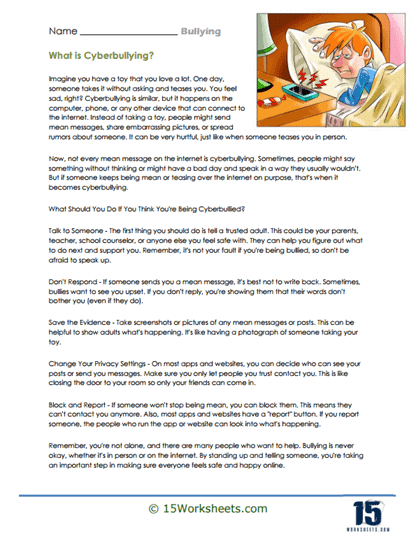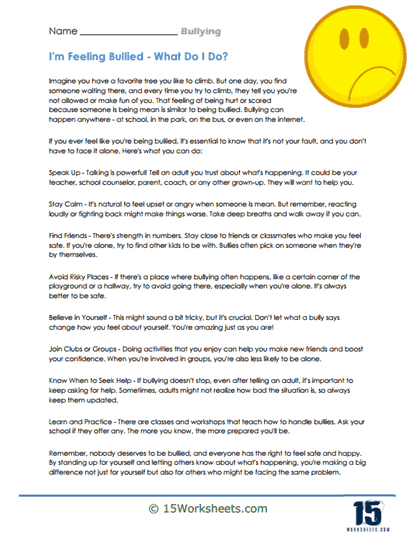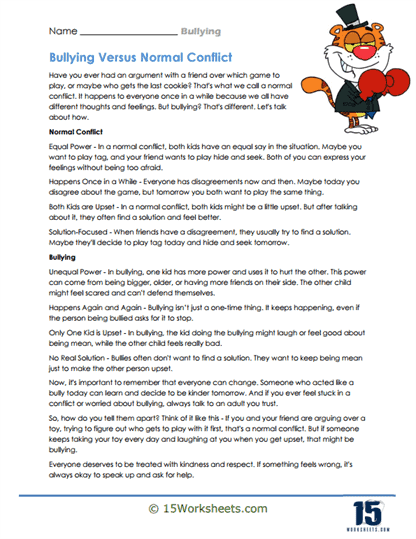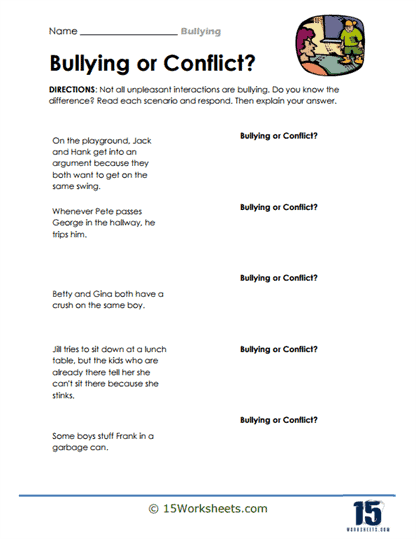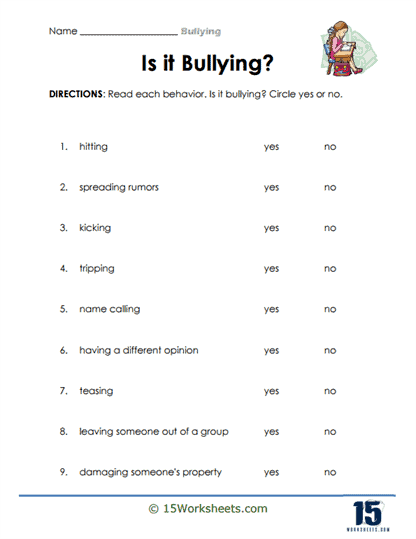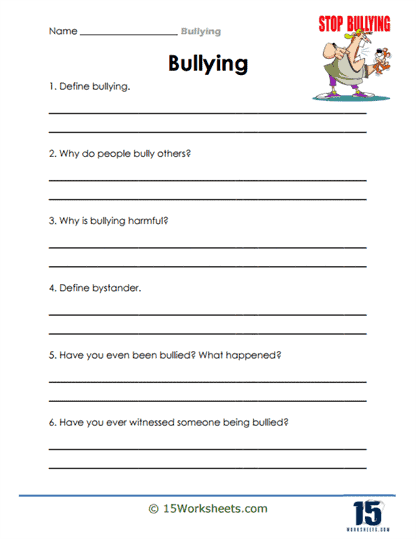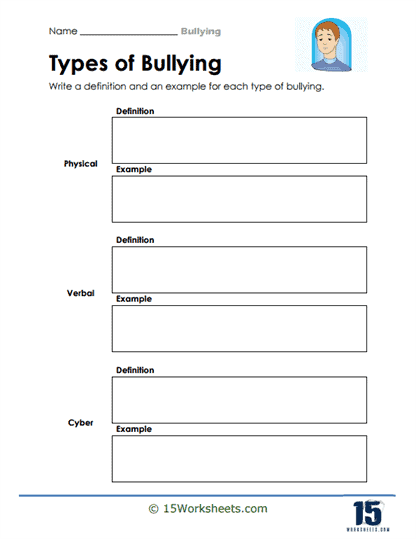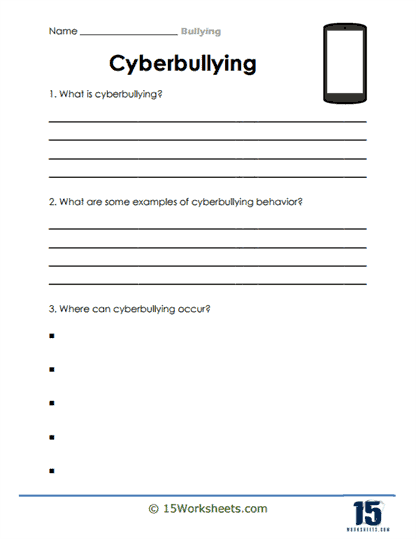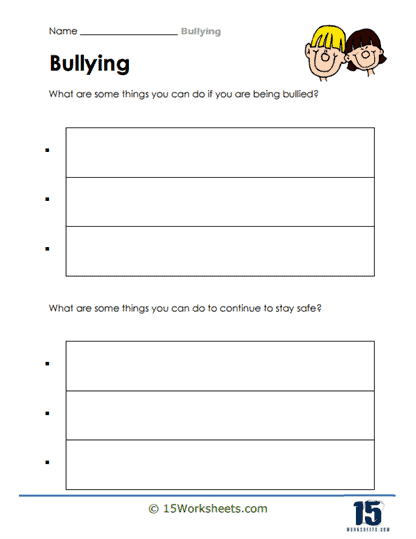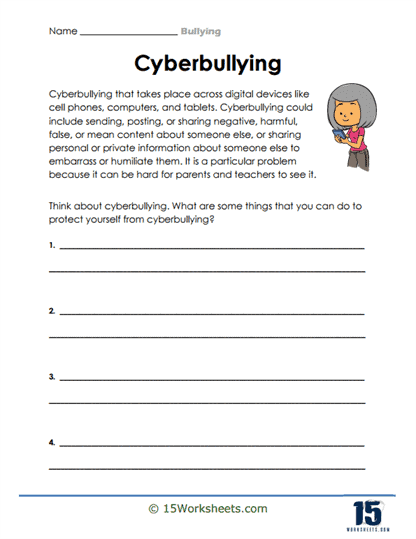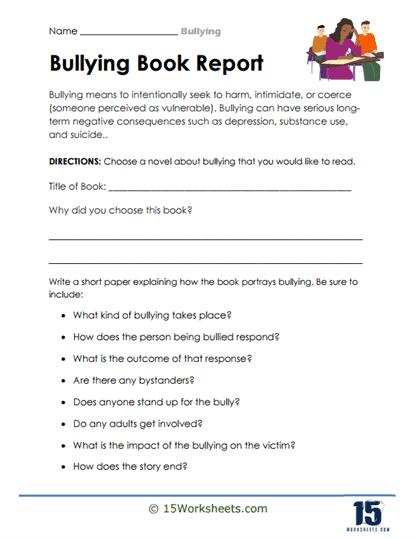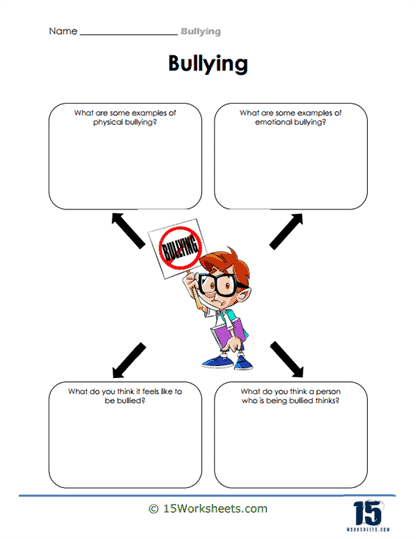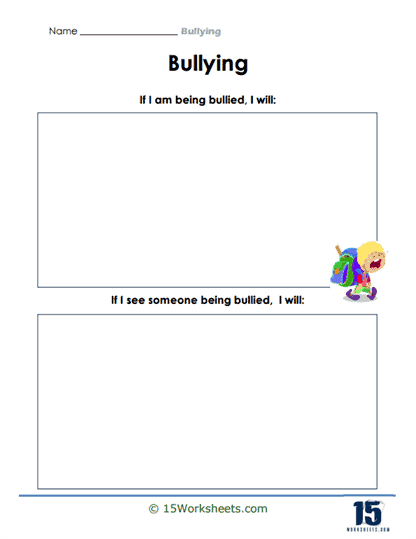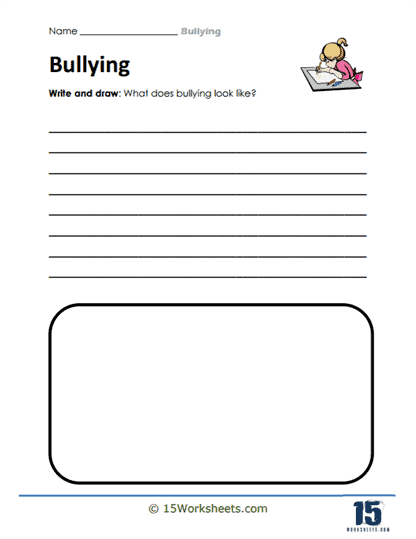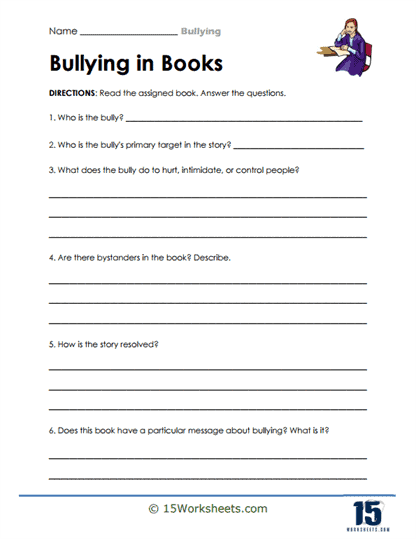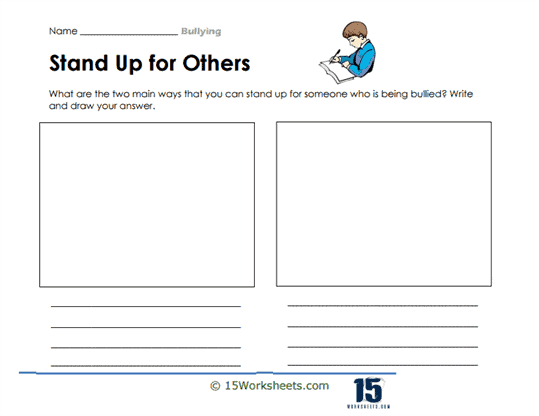Bullying Worksheets
About These 15 Worksheets
Bullying worksheets help you understand and tackle bullying, an issue that can sometimes make our world a little less bright. These worksheets are like maps guiding you through the journey of empathy, respect, and standing up against hurtful behavior.
The journey begins with “What is Cyberbullying?” and “All About Cyberbullying,” where kids learn that bullying doesn’t just happen on the playground-it also lurks behind anonymous usernames and suspiciously aggressive emojis. They get schooled on how to spot shady online behavior faster than you can say “block and report.” By the time they’re done, they’ll be looking at their phones like amateur FBI agents.
Next, it’s time to get personal with “I’m Feeling Bullied – What Do I Do?” and “Three Concerns.” These worksheets are like emotional life jackets tossed into the stormy sea of middle school drama. Students write about their worries, and for once, it’s not just about homework or whether broccoli should be illegal. “What You Can Do” and “Protecting Yourself” give them actual strategies to survive social chaos-spoiler alert: pretending to be a rock doesn’t make the bullies go away, but setting boundaries and finding adult support just might.
Now, in the thrilling worksheet sequel, kids explore “Bullying Versus Normal Conflict,” “Know The Difference,” and “Yes Or No.” Here, students flex their critical thinking muscles to distinguish between a bully and a classmate who just didn’t want to trade fruit snacks. Then they tackle “Open-Ended Questions” and “Learn The Types“-the educational equivalent of opening Pandora’s lunchbox. Verbal, social, physical, and cyberbullying? Oh my! Fortunately, this worksheet series doesn’t require a minor in psychology to understand the nuance-just a healthy sense of right and wrong (and maybe a good eraser).
Finally, it’s reflection time, and this is where things get deep-and sometimes dramatic. “Writing A Book Report” and “Depiction In Literature” invite students to explore bullying in stories, which usually ends with someone learning a valuable life lesson (or at least getting a satisfying comeuppance). Then comes “Some Examples,” “Experiences And Reflections,” and “What Will You Do?“-the holy trinity of “put yourself in someone else’s sneakers.” Add in “What It Looks Like” and “Stand Up For Others,” and you’ve got the complete anti-bullying starter pack. If these worksheets don’t help kids understand how to be better humans, then at least they’ll know enough to not be the reason someone cries in the bathroom stall.
What is Bullying?
Bullying happens when someone repeatedly hurts, threatens, or puts down another person on purpose. It’s not a one-time thing—it’s when someone keeps being mean or hurtful over and over again. Bullying can come in many forms:
Verbal Bullying: This is when someone uses hurtful words, like name-calling, teasing, or making mean jokes.
Physical Bullying: Physical bullying involves hurting someone’s body or belongings, like hitting, pushing, or taking things without permission.
Social Bullying: This happens when someone tries to hurt another person’s friendships or reputation. It could be spreading rumors or leaving someone out on purpose.
Cyberbullying: In the digital world, cyberbullying occurs when someone uses the internet or devices to hurt or embarrass others. This could be sending mean messages, spreading rumors online, or sharing hurtful images.
The Types of Exercises on These Worksheets
1. Identifying Bullying – The first step to tackling bullying is recognizing it. On these worksheets, you might find scenarios or descriptions of situations. Your task is to identify whether the situation is an example of bullying or not. This exercise helps you understand what bullying looks like and how to recognize it in different forms.
2. Understanding Feelings – Empathy is like a superpower—it helps you understand how others feel. You might come across stories where someone is being bullied, and you’ll be asked to imagine how that person feels. This exercise helps you put yourself in someone else’s shoes and realize the impact of hurtful actions.
3. Role-Playing Scenarios – These worksheets might have role-playing exercises where you imagine yourself in a situation involving bullying. You’ll get to think about how you would respond, whether it’s standing up for the person being bullied or seeking help from a trusted adult.
4. Brainstorming Solutions – Bullying worksheets often encourage you to brainstorm creative solutions to bullying situations. You’ll become a problem solver, thinking of ways to stop bullying and create a safe environment for everyone. Some worksheets focus on discussing the concepts of respect and empathy. You might read stories that highlight these qualities and discuss why they’re important in preventing bullying and building positive relationships.
5. Experience Sharing – Bullying can sometimes affect our self-confidence. These worksheets might have exercises that help you build a strong sense of self-worth and understand that nobody deserves to be mistreated. In some cases, you might be asked to share your own experiences or thoughts about bullying. This can help create an open dialogue and show that everyone’s feelings and opinions matter.
How These Exercises Help
1. Awareness and Recognition – By identifying bullying scenarios, you become more aware of hurtful behavior. This awareness helps you recognize and address bullying in real life. Exercises that focus on understanding feelings boost your empathy superpower. You learn to treat others with kindness and consideration, making the world a more compassionate place.
2. Self-Empowerment – Learning to stand up against bullying helps you feel confident and empowered. You realize that you have the ability to make a positive impact. Brainstorming solutions to bullying situations sharpens your problem-solving skills. You’ll be equipped with strategies to stop bullying and create a positive atmosphere.
3. Communication Skills – Role-playing scenarios and discussing respect enhance your communication skills. You learn to express your thoughts and feelings effectively while listening to others with empathy. Understanding respect and empathy helps you build strong and positive relationships with others. This can lead to a happier and more inclusive community.
4. Spreading Kindness – Creating anti-bullying pledges and posters empowers you to spread kindness and awareness. It’s like planting seeds of positivity that grow and flourish. By sharing personal experiences and thoughts, you encourage open conversations about bullying. You become a changemaker, inspiring others to take action against hurtful behavior.

